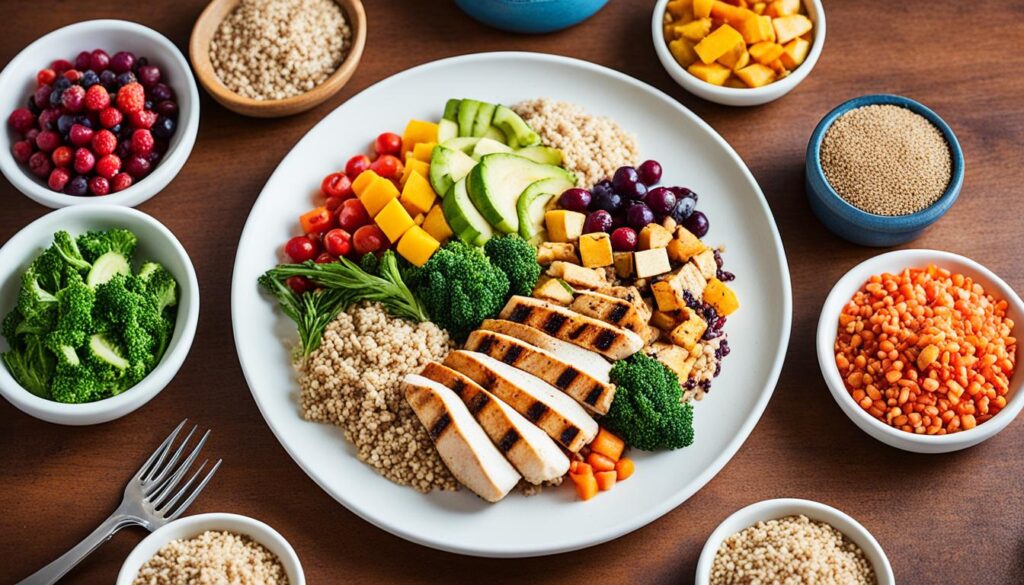Did you know that a small increase in muscle mass can boost your metabolism by up to 7%? This shows how big of an impact building muscle can have on your health and fitness. Whether you’re a pro at the gym or just starting, learning how to use Dr. Muscle products can help you grow your muscles and improve your health.
This guide will cover the science behind muscle growth, the benefits of building muscle, and how to use Dr. Muscle products effectively. By the end, you’ll know how to start on your path to a stronger, more toned body.
Key Takeaways
- Understand the concept of muscle hypertrophy and the factors that influence it
- Discover the wide-ranging benefits of building muscle, from improved aesthetics to enhanced performance and metabolic health
- Learn how to properly use Dr. Muscle products to support your muscle-building goals
- Explore effective training methods and strategies for achieving optimal muscle growth
- Uncover the importance of lifestyle factors, such as nutrition, stress management, and sleep, in supporting muscle development
Understanding Muscle Hypertrophy
Muscle hypertrophy means your muscles get bigger because muscle cells grow. This is different from hyperplasia, which makes more cells. Most of muscle is water, about 75%. But, muscle growth is really about how cells make and break down proteins.
When your body makes more proteins than it breaks down, your muscles grow. But if breakdown wins, your muscles will get smaller.
Factors Affecting Muscle Hypertrophy
Diet and stress are the main things you can control to help your muscles grow. Research shows these key things matter for muscle growth:
- Training volume: More sets each week can help you build more muscle.
- Training frequency: Working out your muscles more often can help them grow.
- Load (weight): Lifting heavier weights is key for muscle growth.
- Exercise selection: Doing exercises that work many muscles at once is better for building muscle.
For beginners, training each muscle group 2-3 times a week works well. For those with more experience, training 3-4 times a week for upper body and 2-3 times for lower body can lead to better results. Getting these training details right is key for the best muscle hypertrophy, muscle growth, and muscle building.
“Tension (how heavy you lift) is the main driver of muscle hypertrophy.” – Brad Schoenfeld, Ph.D.
Benefits of Building Muscle
Building muscle is more than just about looking good. It’s key to our overall health and fitness. It boosts our physical performance by making us stronger, more powerful, and able to last longer. This helps us reach our fitness goals faster.
Also, muscle building advantages help us burn calories even when we’re not moving. This means we can manage our weight better and keep a healthy metabolism. It’s one of the big reasons why importance of muscle growth is so big.
Strength training also lowers the risk of problems that come with aging. It helps us stay independent, avoid falls, and prevent bone breaks. As we get older, keeping our muscles strong is key to living well and doing things on our own.
| Benefit | Impact |
|---|---|
| Improved Aesthetics | Enhanced muscle definition and physique |
| Enhanced Physical Performance | Improved strength, power, and endurance |
| Increased Metabolism | Elevated resting metabolic rate, aiding in weight management |
| Reduced Risk of Age-Related Issues | Decreased likelihood of loss of independence, falls, and bone fractures |
| Improved Overall Health | Stronger heart, better blood pressure and blood glucose management, increased bone density |
In conclusion, the benefits of building muscle are huge. Adding strength training to our fitness routine brings many health and performance benefits. These can greatly improve our lives.
Nutritional Strategies for Muscle Growth
Building and maintaining muscle mass needs proper nutrition. We need a balanced mix of protein, carbohydrates, and healthy fats for muscle growth. Knowing how these nutrients help us can make a good meal plan for building muscle.
Importance of Nutrition for Building Muscle
Nutrition is key for muscle growth. Our muscles need enough calories and nutrients to repair and grow after exercise. Without the right nutrition, our gym work won’t pay off.
Setting Your Macros
To grow muscles, figure out how much protein, carbs, and fats you need. Aim for 1-1.5 grams of protein, 2-3 grams of carbs, and 0.5-1 gram of healthy fats per pound of body weight. This helps create a base for muscle building.
Meal Planning for Muscle Building
Good meal planning for muscle gain means eating 3-4 balanced meals a day. Each meal should have protein, carbs, and healthy fats. Choose whole foods like lean meats, complex carbs, and healthy fats to help your muscles grow and recover.
| Macronutrient | Recommended Daily Intake | Benefits for Muscle Growth |
|---|---|---|
| Protein | 1-1.5 g per pound of body weight | Supports muscle protein synthesis and repair |
| Carbohydrates | 2-3 g per pound of body weight | Provides energy for muscle contractions and recovery |
| Healthy Fats | 0.5-1 g per pound of body weight | Supports hormone production and overall health |
By focusing on nutrition for muscle building, using the right macronutrients for muscle growth, and eating balanced meals, we can support muscle growth. This helps us reach our fitness goals.

Dr. Muscle how to use it
Using Dr. Muscle, our AI-powered workout app, is easy. It has a simple interface and smart features. Using Dr. Muscle helps you reach your fitness goals easily.
Start with the app’s free trial to try all the premium features. This lets you get to know the app’s cleaning instructions, usage guide, and customization options.
- First, set up your profile with your fitness level, goals, and preferences. This helps Dr. Muscle create a workout plan just for you.
- Explore the huge library of over 500 exercises and 34+ workout routines. Whether you want to clean with Dr. Muscle or build muscle, the app has it all.
- Use the app’s cool features like deloads, rest-pause sets, and daily undulating periodization (DUP). These help you clean with Dr. Muscle and build muscle better.
- Keep track of your progress with the detailed tracking system. You can see your workout history, how you did in exercises, and your overall progress.
By using Dr. Muscle regularly and following its advice, you’ll see great results in your fitness journey. Discover the power of AI-driven Dr. Muscle cleaning instructions. Change your body with this cutting-edge workout app.

“Dr. Muscle has been a game-changer for me. The app’s ability to customize my workouts and track my progress has been invaluable in helping me reach my fitness goals.”
Dr. Muscle is great for anyone, from beginners to fitness pros. Dr. Muscle is your go-to for effective cleaning with Dr. Muscle and getting stronger and healthier. Begin your journey now and discover the secrets to great muscle growth and fitness.
Effective Training Methods for Hypertrophy
Building muscle is a key goal for many fitness lovers. To do this, we need to use training methods that push our muscles to grow. Progressive overload – slowly adding more weight, reps, or sets – is crucial for muscle growth.
Creating a Workout Plan
When making a muscle building workout, think about your fitness level, goals, and how much time you have. Try to do 3-4 resistance training sessions each week, hitting all major muscle groups. This can include weightlifting, bodyweight exercises, and other hypertrophy training methods.
Progressive Overload
To keep challenging your muscles and making them grow, progressive overload is key. This means slowly adding more weight, reps, or sets over time. By making your muscles work harder, you tell your body to build more muscle to meet the demands.
“Resistance training, such as weightlifting or bodyweight exercises, is essential for building muscle, as it challenges your muscles and encourages them to grow.”
Creating a good muscle building plan and using progressive overload are key to reaching your muscle goals. By always pushing your muscles and slowly upping the intensity, you’ll get closer to the physique you want.
Lifestyle Factors for Optimal Muscle Building
Building muscle is more than just about what you eat and exercise. Lifestyle factors like stress management and sleep are also key. Chronic stress can hurt muscle building by raising cortisol levels and messing with sleep and recovery. To handle stress, try meditation, yoga, or deep breathing.
Stress Management
Stress can really affect your muscle building. Chronic stress raises cortisol levels, which can cause muscle loss and slow muscle growth. Here are some ways to manage stress:
- Meditation: Regular meditation can lower stress and help you relax, aiding muscle building.
- Yoga: This practice combines physical poses, breathing, and meditation, great for stress relief.
- Deep breathing: Spend a few minutes daily on deep, controlled breaths to reduce stress and feel calm.
Sleep
Sleep is vital for muscle building and recovery. Your body makes growth hormone during sleep, which helps repair and build muscle. Aim for 7-9 hours of quality sleep each night and keep a regular sleep schedule. Good sleep also helps control cortisol levels, helping with muscle building and maintenance.
“Proper sleep and stress management are just as important as diet and exercise when it comes to building and maintaining muscle mass.”
For the best muscle building results, focus on both your body and lifestyle. Make sure to manage stress and get enough sleep. This will help your body perform at its best and reach your muscle goals.
Conclusion
Building muscle can seem tough, but it’s doable with the right plan. Focus on nutrition, exercise, and lifestyle changes to see results. Remember, it takes time, effort, and patience, so stay committed and keep pushing.
The journey to muscle building is tough, but the outcomes are great. Key takeaways from this guide include using periodization models and RIR-based RPE to control training intensity. Also, the Dr. Muscle app can help streamline the process. By following these principles, we can move closer to our fitness goals and get the physique we want.
Building muscle is about the journey, not just the end result. With dedication, patience, and the right strategies, we can change our bodies and feel stronger and more confident. Let’s take on this challenge and start a rewarding path to the body we’ve always wanted.



